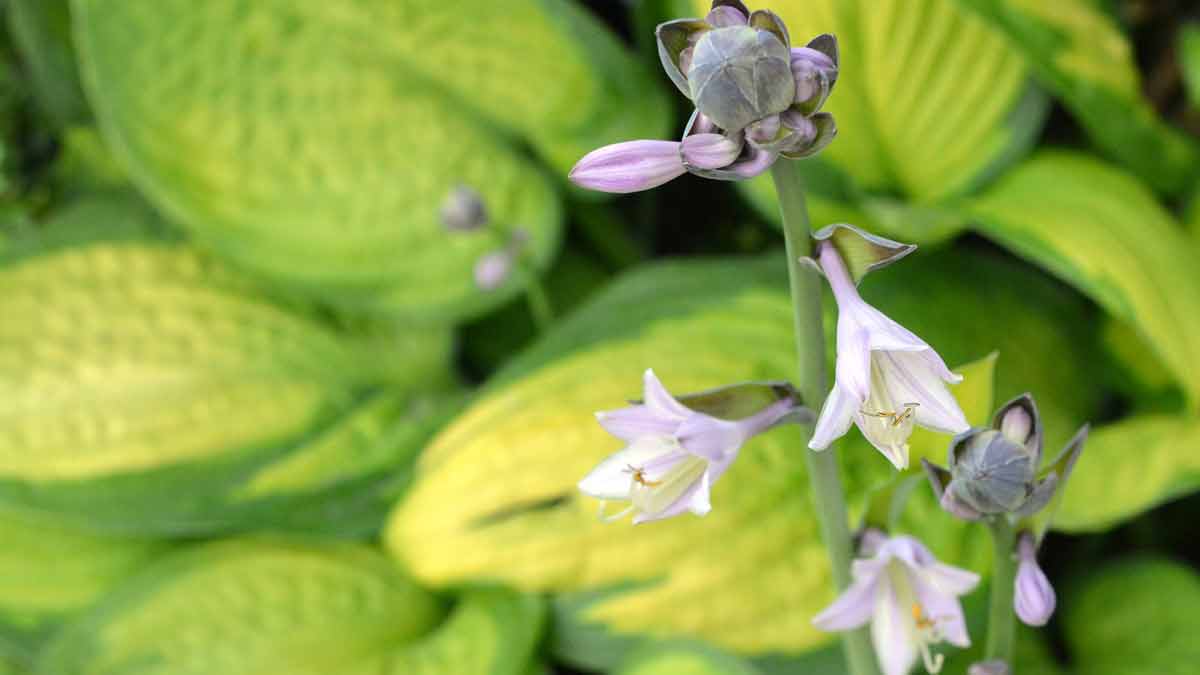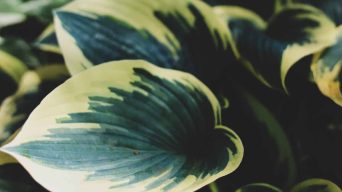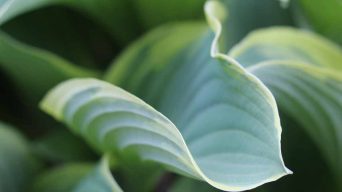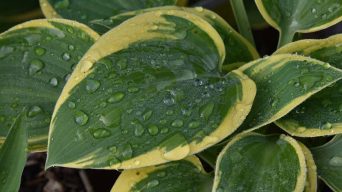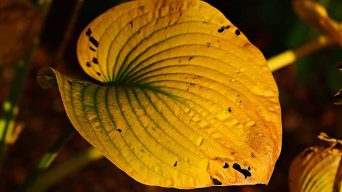Hosta plants are a common sight in many gardens and are known for their large, green leaves.
However, sometimes hosta leaves can turn yellow, which can be alarming for gardeners.
There are several reasons why this may happen, but several solutions exist.
Here are eleven possible reasons why your hosta leaves may turn yellow, as well as what you can do to fix the problem.
What Causes Hosta Leaves to Turn Yellow? (And How To Fix It)
There are several reasons why hosta leaves may turn yellow. Here are some of the most common causes and what you can do to fix them.
1. Overwatering
Overwatering is one of the most common reasons hosta leaves turn yellow.
Hostas are not particularly drought-tolerant, but they can tolerate some dryness.
If you overwater your hostas, their leaves will turn yellow and wilt.
Overwatering happens when the soil around the hostas stays too wet for too long.
It can lead to several problems, including root rot and fungal diseases.
How To Tell If You Are Overwatering Your Hostas
There are a few tell-tale signs that you are overwatering your hostas.
- The leaves will start to turn yellow.
- The leaves will wilt, even when the soil is moist.
- The roots will start to rot.
- You will see fungal diseases, such as powdery mildew or leaf spot.
- Brown or yellow patches will appear on the leaves.
If you see any of these signs, you must take action immediately.
How To Fix Overwatering
If you think you are overwatering your hostas, the best thing is to let the soil dry out completely before watering them again.
Letting the soil dry out will give the roots a chance to recover.
It is also a good idea to ensure that your hostas are planted in well-draining soil.
If the soil does not drain well, the roots will not be able to get the oxygen they need, and they will start to rot.
You can improve drainage by adding organic matter, such as compost, to the soil.
You may also want to consider planting your hostas in a raised bed. This will help to improve drainage and prevent the roots from sitting in water.
Hosta plants need about 1 inch of water per week.
You can use a garden hose with a sprinkler attachment or a soaker hose to water your hostas.
If you use a garden hose, water the base of the plant, not the leaves.
Watering the leaves can cause leaf spot and other diseases.
2. Underwatering
Underwatering is another common reason for hosta plant leaves to turn yellow.
Hostas need a consistent level of moisture, and if they do not get enough water, their leaves will start to turn yellow.
The soil around the hostas should be moist but not soggy.
If the soil is dry for too long, the hostas will start to wilt.
When the plant doesn’t get enough water, it won’t be able to produce the food it needs to stay healthy.
As a result, the leaves will turn yellow and eventually die.
How To Tell If You Are Underwatering Your Hostas
There are a few signs that you are underwatering your hostas.
- The leaves will start to turn yellow.
- The leaves will wilt.
- The soil will be dry to the touch.
- Brown spots will appear on the leaves.
- The hosta leaves will curl or droop.
If you see any of these signs, you must take action immediately.
How To Fix Underwatering
If you think you are underwatering your hostas, the best thing to do is to water them deeply and then let the soil dry out completely before watering them again.
Watering deeply will help to encourage deep roots.
Hostas need to be watered about once a week.
If it is particularly hot or dry, you may need to water them more often.
3. Water Quality
Another common reason for hosta leaves to turn yellow is water quality.
If the water you are using to water your hostas is high in chlorine, it can cause the leaves to turn yellow.
Chlorine is a chemical added to municipal water supplies to kill bacteria.
While it is safe for humans, it can be harmful to plants.
Chlorine can cause the leaves of plants to turn yellow, and it can also damage the roots.
How To Tell If The Water Is Too Chlorinated
There are a few signs that the water you are using to water your hostas is too chlorinated.
- The leaves will start to turn yellow.
- The leaves will wilt.
- Brown spots will appear on the leaves.
- The tips of the leaves will turn brown.
- The roots will be damaged.
- The plant will be stunted.
If you see any of these signs, you must take action immediately.
How To Fix Water Quality Issues
If you think the water you are using to water your hostas is too chlorinated, the best thing to do is to let the water sit for 24 hours before using it.
This will allow the chlorine to evaporate and make the water safe for your plants.
You can also use distilled water or rainwater for watering your houseplants.
4. Nutrient Deficiencies
Nutrient deficiencies are another common reason for hosta leaves to turn yellow.
Hostas need several nutrients to stay healthy, including nitrogen, phosphorus, and potassium.
If the soil around your hostas is lacking in these nutrients, the leaves will start to turn yellow.
This is because the plant is not getting the food it needs to stay healthy.
How To Tell If Your Hostas Are Lacking Nutrients
There are a few signs that your hostas are lacking nutrients.
- The leaves will start to turn yellow
- The leaves will be small and stunted
- The plant will not produce as many flowers as it should
- The plant will generally look unhealthy
If you see any of these signs, you must take action immediately.
How To Fix Nutrient Deficiencies
If you think your hostas lack nutrients, the best thing to do is fertilize them.
Hostas need to be fertilized about once a month during the growing season.
You can use a liquid fertilizer or a slow-release fertilizer.
You can also add compost to the soil around your hostas. This will help to add nutrients to the soil and will also help to improve drainage.
5. Lack of Light
Another common reason for hosta leaves to turn yellow is a lack of light.
Hostas need four hours of direct sunlight per day to stay healthy.
If they don’t get enough light, the leaves will start to turn yellow.
Light is essential for the plant to photosynthesize and produce food.
If the plant doesn’t get enough light, it will not be able to produce food, and the leaves will start to turn yellow.
How To Tell If Your Hostas Are Not Getting Enough Light
There are a few signs that your hostas are not getting enough light.
- The leaves will start to turn yellow.
- The leaves will be smaller than usual.
- The plant will not be as vigorous as it should be.
- The plant will stretch out towards the light.
- The plant will grow leggy and thin.
If you see any of these signs, you must take action immediately.
How To Fix The Problem
If you think your hostas are not getting enough light, the best thing to do is to move them to a location that gets more light.
Hostas thrive in bright indirect light, so a location that gets four hours of direct sunlight per day would be ideal.
When grown indoors, hostas need to be placed near an east- or west-facing window. This will ensure that they get enough light during the day.
If you can’t move your hostas to a brighter location, you can try growing them under grow lights.
Grow lights are artificial lights that simulate the sun and provide plants with the light they need to photosynthesize.
6. Too Much Sunlight
While hostas need a minimum of four hours of direct sunlight per day to stay healthy, too much sunlight can also cause the leaves to turn yellow.
Hostas are shade-loving plants; too much sun will scorch the hosta leaves and cause them to turn yellow.
How To Tell If Your Hostas Are Getting Too Much Sunlight
There are a few signs that your hostas are getting too much sun.
- The leaves will start to turn yellow or brown.
- The leaves will be dry and crispy.
- The plant will appear to be wilted.
- Brown or black spots will appear on the leaves.
If you see any of these signs, you must take action immediately.
How To Fix The Problem
If you think your hostas are getting too much sun, the best thing to do is to move them to a location that gets less light.
Hostas need indirect sunlight or dappled sunlight to thrive.
You can also try to protect your hostas from the sun by covering them with a light-colored cloth or placing them under a tree.
Avoid using dark-colored cloth as this can make the problem worse by trapping heat.
7. Transplant Shock
Transplant shock is a condition that occurs when a plant is moved to a new location.
The plant’s roots are disturbed, and the plant goes into shock.
This can cause the leaves to turn yellow or brown as the plant tries to adjust to its new environment.
Transplant shock is most likely to occur when a plant is moved from a pot to the ground or when it is moved to a new location in the garden.
How To Tell If Your Hosta Is Experiencing Transplant Shock
There are a few signs that your hosta is experiencing transplant shock.
- The leaves will start to turn yellow or brown.
- The leaves will start to droop.
- The plant will appear to be wilted.
- The plant will not grow as vigorously as it should.
If you see any of these signs, you must take action immediately.
How To Fix The Problem
If you think your hosta is experiencing transplant shock, the best thing to do is to give it time.
Transplant shock can take a few weeks or even months to recover.
During this time, it’s essential to make sure that the plant has enough water and is in a location that receives the right amount of light.
8. Temperature Stress
Temperature stress is a condition that occurs when a plant is exposed to extreme temperatures.
This can cause the leaves to turn yellow or brown as the plant tries to adjust to the new environment.
Temperature stress is most likely to occur when a plant is placed in an area that is too hot or too cold.
How To Tell If Your Hosta Is Experiencing Temperature Stress
There are a few signs that your hosta is experiencing temperature stress.
- The leaves will turn yellow or brown.
- The plant may stop growing altogether.
- The leaves may become wilted or dried out.
- The plant may become more susceptible to pests and diseases.
If you see any of these signs, you must take action immediately.
How To Fix The Problem
If you think your hosta is experiencing temperature stress, the best thing to do is to move it to a location that has more moderate temperatures.
Hostas prefer temperatures between 60 and 75 degrees Fahrenheit.
You can also protect your hosta from extreme temperatures by covering it with a cloth or placing it in a sheltered location.
When the temperatures cool down in the fall, you can gradually move your hosta to a location that gets more sun.
9. Pest Infestation
Pest infestations are one of the most common problems that gardeners face.
Several pests can infest hostas, including aphids, slugs, and Japanese beetles.
Aphids are small, soft-bodied insects that feed on the sap of plants.
Slugs are slimy creatures that feast on the leaves of plants.
Japanese beetles are shiny, hard-bodied insects that strip the leaves of plants.
Pest infestations can cause the leaves of a plant to turn yellow or brown.
They can also cause the plant to stop growing and become more susceptible to diseases.
How To Tell If Your Hosta Is Experiencing A Pest Infestation
There are a few signs that your hosta is experiencing a pest infestation.
- The leaves of the plant may turn yellow or brown.
- The plant may stop growing.
- The plant may become more susceptible to diseases.
- The leaves may be covered in a sticky substance.
- The leaves may be chewed or shredded.
- The plant may be wilting.
If you see any of these signs, you must take action immediately.
How To Treat A Pest Infestation
If you think your hosta is infested with pests, you should first isolate the plant from the rest of your garden.
This will prevent the pests from spreading to other plants.
Next, you’ll need to remove the pests from the plant.
You can do this by hand or with a hose. To remove aphids, simply spray them off of the plant with water.
To remove slugs, pick them off the plant or place a board next to it and check it in the morning for slugs that have crawled underneath.
To remove Japanese beetles, handpick them off of the plant or use a trap.
After you’ve removed the pests, you’ll need to treat the plant with a natural insecticide.
There are several different insecticides that you can use, but neem oil is one of the most effective.
Neem oil is a natural substance that comes from the seeds of the neem tree.
It’s safe to use on plants and kills any remaining pests.
10. Diseases
Diseases are another common problem that gardeners face.
Several diseases can affect hostas, including petiole rot, powdery mildew, and bacterial leaf spot.
Petiole rot is a disease that affects plants’ petioles, or leaf stems, causing them to turn yellow or brown.
Powdery mildew is a fungal disease that covers the leaves of plants in a white powder.
Bacterial leaf spot is a bacterial disease that causes spots on the leaves of plants.
Diseases can cause the leaves of a plant to turn yellow or brown.
They can also cause the plant to stop growing and become more susceptible to pests and diseases.
How To Tell If Your Hosta Is Experiencing A Disease
There are a few signs that your hosta is experiencing a disease.
- The leaves of the plant may turn yellow or brown.
- The plant may stop growing.
- The plant may become more susceptible to pests and diseases.
- The leaves may be turning white.
- The leaves may have spots on them.
- The plant may be wilting.
If you see any of these signs, you must take action immediately.
How To Treat A Disease
If you think your hosta is infected with a disease, you should first isolate the plant from the rest of your garden.
This will prevent the disease from spreading to other plants.
Next, you’ll need to remove any affected leaves.
You can do this by hand or with a pair of pruning shears.
After you’ve removed the affected leaves, you’ll need to treat the plant with a fungicide.
There are several different fungicides that you can use, but copper sulfate is one of the most effective.
Copper sulfate is a natural substance that is derived from copper.
It’s safe to use on plants and kills any remaining diseases.
11. Natural Leaf Yellowing
In some cases, the leaves of a hosta may turn yellow due to natural causes.
The most common cause of leaf yellowing is senescence, which is the process of a plant breaking down its tissues.
Senescence is a normal part of a plant’s life cycle, and it usually occurs in the fall as the plant prepares for winter.
How To Tell If Your Hosta Is Experiencing Natural Leaf Yellowing
There are a few signs that your hosta is experiencing natural leaf yellowing.
- The leaves will turn yellow from the bottom of the plant up.
- The leaves will become thin and papery.
- The margins of the leaves will curl inward.
- The plant will produce fewer flowers.
If you see any of these signs, you must take action immediately.
How To Treat Natural Leaf Yellowing
If you think your hosta is experiencing natural leaf yellowing, you should cut back on the amount of water you’re giving the plant.
You should also remove any affected leaves.
You can do this by hand or with a pair of pruning shears.
After you’ve removed the affected leaves, you’ll need to fertilize the plant.
Fertilizing will help the plant produce new growth, and it will also help to prevent future yellowing leaves.
There are several different fertilizers that you can use, but organic compost is one of the best.
Organic compost is a natural substance made up of decomposed plant matter.
It’s safe to use on plants, and it will provide them with the nutrients they need to produce new growth.
How To Prevent Yellow Hosta Leaves
Preventing yellow hosta leaves is key to having a healthy plant. While there are many potential causes of yellow leaves, here are 10 solutions to preventing and fixing the problem.
- Fertilize properly. Hostas are heavy feeders and need to be fertilized regularly. A lack of nutrients can cause the leaves to turn yellow.
- Water regularly. Hostas need at least 1 inch of water per week. If the soil is too dry, the leaves will start to turn yellow.
- Mulch regularly. Mulching helps to retain moisture and keeps the roots cool.
- Avoid over-exposure to the sun. Hostas need at least 4 hours of sun per day, but too much sun can cause the leaves to turn yellow.
- Avoid chemicals. Chemicals can build up in the soil and cause the leaves to turn yellow.
- Prune regularly. Pruning helps to keep the plant healthy and prevents the yellowing of leaves.
- Inspect for pests. Pests can damage the leaves and cause them to turn yellow.
- Check for diseases. Diseases can also cause the leaves to turn yellow.
- Use well-drained soil. Soil that is too wet can cause the leaves to turn yellow.
- Ensure the pot has drainage holes. A pot without drainage holes can cause the leaves to turn yellow.
Following these 10 solutions can prevent your hosta leaves from turning yellow.
Final Thoughts
If you notice your hosta leaves turning yellow, it could be caused by several different things.
The most important thing to do is to figure out what is causing the problem so that you can take steps to fix it.
In most cases, yellowing hosta leaves are caused by one of three things: too much or too little sun, too much water, or a nutrient deficiency.
By taking steps to correct these issues, you should be able to get your hosta leaves back to their healthy green state in no time.

